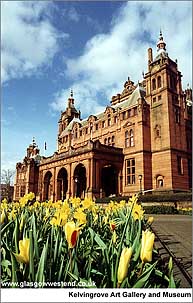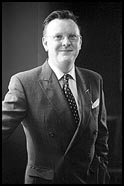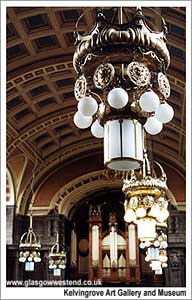Kelvingrove Art Gallery and Museum: Refurbishment
Refurbishment of Kelvingrove, July, 2003 - March, 2006.
Read May 2006 News on the Kelvingrove Art Gallery and Museum refurbishment.
 Designed for the 1901 Exhibition by architects John Simpson and E.J. Milner, Kelvingrove Art Gallery and Museum opened in 1902 . Situated on the banks of the Kelvin in the shadow of the University of Glasgow's Gothic steeples it is an impressive sight set within a glorious background.
Designed for the 1901 Exhibition by architects John Simpson and E.J. Milner, Kelvingrove Art Gallery and Museum opened in 1902 . Situated on the banks of the Kelvin in the shadow of the University of Glasgow's Gothic steeples it is an impressive sight set within a glorious background.
Kelvingrove is said to be Glasgow's most loved building and is a major attraction to city dwellers and tourists; the most visited Museum in the UK outside London. It is home to many wonderful pieces of art and interesting anthropological and archaeological collections. Its natural history collection is a favourite with school children and many of us will remember our childrens' faces when they first encountered the dinosaurs, and the elephant and baby elephant.
It is no chore finding sentimental thoughts about Kelvingrove and we all have our favourite pieces. It houses the work of many wonderful Scottish artists including the Glasgow Boys and Girls; Charles Rennie Mackintosh and the 'Colourists' such as Fergusson, who at one time resided just a stone's throw from the building (in Clouston Street). Not to mention some impressive 'Old Masters'.
Kelvingrove is about to undergo a major refurbishment and will be closed for three years from the 1st July, 2003 - March, 2006. This plan has struck fear into the hearts of many Glaswegians, fondly attached, not only, to the paintings and collections housed within the building but also to the magnificent Victorian interior. Locals have been worried that this fabulous landmark building, could be spoiled by a modern re-design unsympathetic to its Victorian past.
 When Alan Horn, Director of the Kelvingrove Refurbishment Appeal, invited Jim and I along to talk to us about the plans for the building, we were very keen to take up this invitation and we went along to Kelvingrove to meet him last week.
When Alan Horn, Director of the Kelvingrove Refurbishment Appeal, invited Jim and I along to talk to us about the plans for the building, we were very keen to take up this invitation and we went along to Kelvingrove to meet him last week.
Initially, we were so overwhelmed by his wonderful office with original works of art by Peploe, McTaggart, Crawhall, and such like, adorning its walls, that we were stunned into silence. Alan explained that these works had been taken out of storage - and went on to inform us that at Kelvingrove there are 200,000 objects with only 20,000 on display at any time within the gallery. The refurbishment, as Alan explained, will allow 50% more items to be on shown to the public.
It quickly became clear that tremendous thought has gone into the plans to improve and restore the gallery and museum. Much of the work is absolutely essential with 10 million being spent on the fabric of the building - some of the original wiring in the building has never been replaced since electricity was installed in 1898. In fact, it was at Kelvingrove that many Glaswegians saw electric lighting for the first time. Other problems include leaking downpipes, which are embedded within the stone walls of the building. This was an innovative feature for the time as it kept the outside of the building free of clutter, but it is a big job to fix the leaks, the results of which can be seen as stains on the inside walls.
Apart from this essential restoration there are wonderful plans for improvement. Some of this is to ensure that Kelvingrove will meet the requirements necessary to attract major tours to Glasgow (this includes: security, humidity control, lighting) - at present the lack of these features keep Kelvingrove off the major touring circuits.
Further aims include "claiming back space for the public" - at present one third of the floor space is not accessible. Alan explained that originally the Art School was to be housed within Kelvingrove's basement - this was prior to the establishment of Charles Rennie Mackintosh's, now famous building in Renfrew Street.
 We thoroughly enjoyed a tour of the basement and hearing about the great plans for this space. At present it is an administrative center for Glasgow's museums' staff and also provides the storage space for all collections. This area is a contrast to the more majestic higher levels; it is stark and clinical with white brick walls, gray corridors and has a profusion of ugly pipes running along the ceilings.
We thoroughly enjoyed a tour of the basement and hearing about the great plans for this space. At present it is an administrative center for Glasgow's museums' staff and also provides the storage space for all collections. This area is a contrast to the more majestic higher levels; it is stark and clinical with white brick walls, gray corridors and has a profusion of ugly pipes running along the ceilings.
Plans for this area include the main entrance, to be moved to the back of the building at ground level; this will be much more accessible to everyone, including wheelchair users. The entrance will sit aesthetically well, beneath the statue of St Mungo, on the side facing the river Kelvin and Glasgow University. Researchers identified that a very large number of visitors to the gallery never left the ground floor so advice has been taken from marketing experts to ensure that in future people will be aware of all that Kelvingrove has to offer. You will be able to come in and catch your breath and gather the information you need to find your way around the gallery. Both the shop and the restaurant will also be at this level.
Changes will be extensive and highly exciting - the emphasis on educational activity will be a major boost to schools and universities in, and around, Glasgow. There will be a Formal Educational Space for children and Childrens' Discovery Centres - these developments have been informed by what children like to do and also take account of different learning styles. There will be an opportunity for a wide range of activities including: dressing up, story telling and discussion.
The acquisition of knowledge will be supported at various levels and the gallery will be geared up for those who wish to explore subjects in more detail with support from staff and the availability of quiet self-study areas. A facility for Public Research will be available at Nitshill, where the museum store will be located. This will also be a visitor facility with a Learning Centre, tours and workshops. It will house Open Museum Resources, (161 Woodhead Road, South Nitshill Industrial Estate, G53 7NN- Tel 0141 552 2356) taking collections out into the community.
At Kelvingrove there will be also be an Object Cinema and 22 themed galleries focusing on 100 different stories. The paintings 'the star of the show' will be displayed to greater advantage - anyone who has seen the paintings recently moved to the McLellan Gallery, as part of the 'Art Treasures of Kelvingrove' exhibition, will be aware of how fantastic these are, when lit and displayed to advantage.
After meeting Alan we felt very reassured - the plans for Kelvingrove sound exciting, thoughtful and well researched. The Gallery and Museum will retain all of its magnificience - it will still be the perfect setting for the City's wonderful collections and fine art. The building will receive some tender loving care and simultaneously gain 21st Century facilities.
We left feeling that this project was in good hands and we'll be looking forward to the re-opening of Kelvingrove with positive anticipation.
Pat Byrne, 26th May, 2003
Anyone interested in giving a donation to the Kelvingrove Refurbishment Appeal please visit the page at 'Building an exciting future on a proud past'.
Everyone who donates receives a personal thank you letter and a recognition certificate signed by Lord Macfarlane as Chairman of the Appeal.
Alan Horn, Head of Development for Cultural Leisure Services can be contacted at alan.horn@cls.glasgow.gov.uk
Telephone: 00 44 141 287 2604
Fax: 00 44 141 287 2690
For up to date information on exhibitions see our weeklyWhat's On - Jess's Jaunt







